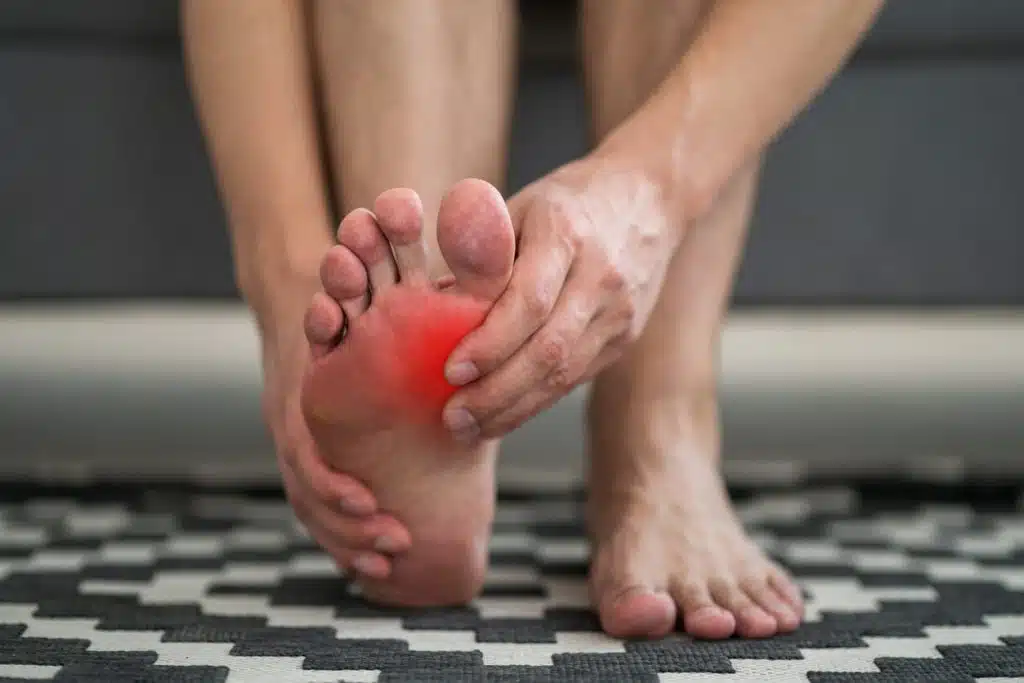
Have you ever felt a sharp pain in your heel when you first step out of bed in the morning? If so, you might be familiar with plantar fasciitis. This common foot problem is like an unwelcome guest for your feet, causing discomfort and pain. Plantar fasciitis is when the band of tissue running across the bottom of your foot, connecting your heel to your toes, gets irritated and inflamed. Think of it like a bowstring that has been pulled too tight.
This article is your guide to understanding this foot issue and offers practical, easy stretches and exercises, as well as medical treatments.
Stretches for Plantar Fasciitis
Alleviating the discomfort of plantar fasciitis can be achieved with some simple yet effective stretches.
Calf Stretch
Stand in front of a wall while keeping your hands on the wall, at about eye level. Place your affected leg about a foot behind the other one. While having your back heel on the ground, bend your front knee up until you feel a stretch in the back leg.
Hold this position for 15-30 seconds and repeat 2-4 times. This stretch helps loosen the calf muscles and the part of the plantar fascia connected to the heel.
Seated Plantar Fascia Stretch
Sit on a chair and cross one leg over the other knee. Grab your toes and tug them gently towards you until you feel a stretch in your foot arch.
Hold for 10-15 seconds and repeat 2-3 times for each foot. This directly targets the tightness in the plantar fascia.
Towel Stretch
Before getting out of bed, wrap a towel way around the ball of your foot and gently pull it towards you while making sure your knee is straight.
You want to hold this position for 15-30 seconds and repeat 2-4 times. This stretch is great for easing morning symptoms.
Regular practice of these stretches, especially in the morning and after long periods of sitting, can significantly reduce the pain and stiffness associated with plantar fasciitis.
Exercises for Relief
In addition to stretching, specific exercises can strengthen the foot muscles, which support the arch and help prevent plantar fasciitis pain.
Towel Curls
Place a small towel on the floor and use your toes to scrunch it towards you, curling it under your foot. Release and repeat 10-15 times. This helps to strengthen the muscles in the bottom of your foot.
Toe Extensions
Place a thick rubber band around all your toes. Spread your toes apart and then relax them, creating resistance with the rubber band. Repeat this 10-15 times.
This exercise helps in building strength in the toes and the plantar fascia.
Marble Pickup
Scatter a few marbles on the ground. Use your toes to pick up one marble at a time. Still with your toes, place it into a cup. Do this for about 1-2 minutes.
This activity improves the control and strength of the muscles in your feet.
Medical Treatments for Plantar Fasciitis
While stretches, exercises, and lifestyle changes can often provide relief for plantar fasciitis, some cases may require medical intervention, especially if the pain persists or worsens.
Physical Therapy
A physical therapist can assess your condition and develop a personalized treatment plan. To reduce pain and improve foot function, they may use techniques such as:
- Ultrasound
- Taping
- Manual therapy
Physical therapy can also help address any underlying biomechanical issues contributing to plantar fasciitis.
Orthotic Devices
Custom or over-the-counter orthotic shoe inserts can provide additional arch support and cushioning.
These devices can help distribute pressure more evenly across the foot and reduce strain on the plantar fascia. They are often used as a conservative treatment option.
Corticosteroid Injections
If the pain and inflammation are severe, a healthcare provider may recommend corticosteroid injections. These can provide short-term relief by reducing inflammation in the affected area.
However, they are typically not used as a long-term solution due to potential side effects.
Tenex Procedure
This minimally invasive procedure involves the removal of damaged tissue in the plantar fascia using ultrasound guidance.
It is performed on an outpatient basis and can provide relief for chronic plantar fasciitis.
Surgery
In rare cases when conservative treatments fail to provide relief from chronic plantar fasciitis pain, surgical intervention may be considered.
Surgical procedures for plantar fasciitis aim to release or remove the tight plantar fascia tissue. Surgery is typically considered a last resort due to the potential risks and recovery time.
Plantar Fasciitis Treatment in Catonsville, MD
Dealing with plantar fasciitis might feel like a journey with your feet, but it is one that can lead to a pain-free destination. Remember, your feet are the foundation of your body, and taking care of them is crucial. By incorporating the stretches and exercises here, along with the other treatments, you can say goodbye to that nagging heel pain. It is all about understanding your feet, giving them the care they need, and being patient.
Are you looking for the best orthopedic surgeon in Baltimore for plantar fasciitis treatment in Catonsville, MD? If so, you can trust Orthopaedic Associates of Central Maryland. Call us today at (410) 644-1880 or use our online appointment request form to book a schedule with us. If you need physical therapy in Baltimore, you can also dial (443) 478-4449.
We look forward to serving you!


